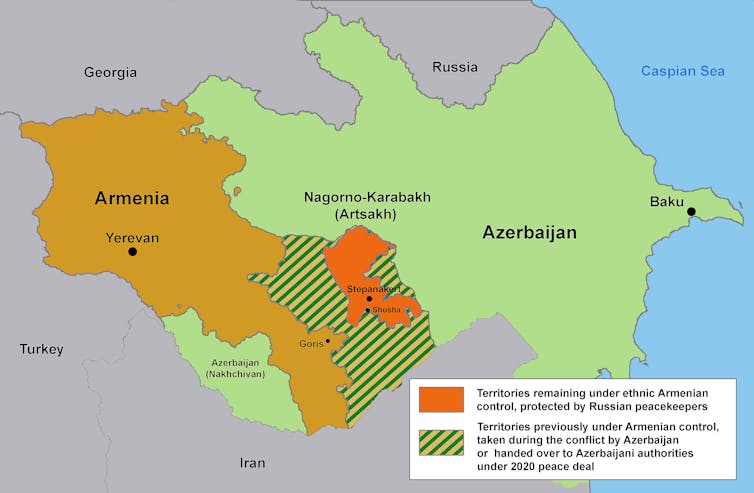A United Nations mission finally arrived in Nagorno-Karabakh on October 1 to find its towns and villages almost completely deserted. Two weeks after Azerbaijan launched an all-out military assault on the disputed territory in the south Caucasus, the Armenian government has said there are now almost no ethnic Armenians left in an area they have lived in for more than two millennia.
The only people left are reportedly either too old, too poor, too remote or too infirm to flee to safety along the Lachin corridor to Armenia.
Before the military assault, Armenians living in the enclave had been trapped and living under siege since December 12, 2022. Azerbaijan established an illegal blockade of the narrow land bridge connecting Nagorno-Karabakh with Armenia, blocking supplies, including food and medicine.
After more than nine months, having reduced the population of 120,000 to near starvation, Azerbaijan launched a military assault on September 19. The attack killed an estimated 200 Armenian troops and seized control of strategic high ground around the enclave.
Under the terms of the ceasefire that followed, both Armenian troops and the 2,000 Russian peacekeepers were required to disarm and disband. Armenians were given the “choice” of “reintegration” into Azerbaijan.
These sanitised terms mask a violence and dispossession that the pictures in the media last week can only hint at. The queues of desperate Armenians fleeing were so long that they could be viewed from space.

Dehumanisation of Armenians
It was always highly unlikely that any Armenians would “choose” to stay under Azeri control of Nagorno-Karabakh. The regime of President Ilham Aliyev does not tolerate criticism or plurality of voice among its own citizens.
So Azerbaijan’s pledge “to protect the rights and safety of ethnic Armenians” has a hollow ring. Azerbaijan is rated as a “consolidated authoritarian regime” by US-based democracy think tank Freedom House, which rates it at a paltry nine out of a possible freedom score of 100 and judges it as “not free”.
For decades, the Aliyev regime has promoted ethnic hatred of Armenians. Azerbaijan has actively worked for the eradication and appropriation of its Armenian religious and cultural heritage. This was referred to in a recent report as “the worst cultural genocide of the 21st century”.
Meanwhile, atrocities committed by Azeri troops during the previous Nagorno-Karabakh war in 2020 have been well documented. The so-called “Military Trophies Park” in the Azeri capital of Baku, built as a memorial of the war, is filled with grotesque mannequins representing Armenians.
Ethnic hatred of Armenians is normalised by the government. A postage stamp issued in 2021 depicted the fumigation of Nagorno-Karabakh, implying that ethnic Armenians were a virus that needed to be eradicated (the stamp was not registered by the Universal Postal Union).
While Nagorno-Karabakh was being emptied, Azerbaijan reissued a map of Stepanakert, the capital city, with Azeri street names. One street has been renamed Enver Pasha, after one of the three Turkish architects of the Armenian genocide of 1915.
Caviar and energy diplomacy
Reporting of the conflict has largely overlooked the complex history and forces involved – as well as wider regional power struggles.
Instead, the global media has been lending credence to Azerbaijan’s script, referring to “anti-terrorist operations” against “separatists” and “ethnic Armenian rebels” to describe the Nagorno-Karabakh Armenians. This language obfuscates the expulsion of 120,000 Armenians from their ancestral homeland by a clear aggressor.
But Azerbaijan wields significant international influence thanks to its immense oil and gas wealth and the unqualified support of its “big brother” Turkey.
In addition, Azerbaijan uses all the propaganda weapons at its disposal. The Aliyev regime has become adept at courting political influence in the west through what has been dubbed “caviar diplomacy”. Events such as the Formula 1 Grand Prix also function as high-profile projections of soft power, effectively “sportwashing” Azerbajan’s corruption and human rights record.
A statement of solidarity with Nagorno Karabakh signed by more than 100 UK academics on September 26 singled out the UK’s close relationship with Azerbaijan and the Aliyev regime as providing “a useful veneer of ‘respectability’ to the laundering of funds and history”.
Azeri impunity
Experts in international law have described the forced exodus of Armenians from their homes as a “war crime”. And former UN independent expert Alfred de Zayas has called for recent events to be investigated by the International Criminal Court.
But since Russia’s invasion of Ukraine, Azerbaijan has become an essential source for western energy. The country now seems to have a protected status as what EU commission president, Ursula von der Leyen, calls a “crucial energy partner”.
The question of sanctions against Azerbaijan has been raised in the EU parliament and expressions of concern have been made by the Council of Europe and the US government. But any concrete action from the west is thought unlikely.
While Armenians were fleeing their homes, an advertisement from the UK’s Department for Business and Trade in The Telegraph of September 29 enthused about the 450 UK companies already doing business in Azerbaijan. It noted that the UK is the country’s largest foreign investor. On the same day, the government announced it would give one million pounds to the International Committee of the Red Cross (ICRC) as a response to “events” in Nagorno Karabakh.
The international spotlight now has understandably shifted to the plight of 120,000 refugees. But the focus on the humanitarian crisis risks overlooking the ethnic cleansing carried out by Azerbaijan and the web of complicity that enabled it.
The fate of Nagorno-Karabakh offers us a glimpse into the casualties of the so-called “rules-based order”, where economic and geopolitical interests and whitewashing campaigns converge to a point where ethnic cleansing is of little note and apparently no consequence.
Sossie Kasbarian does not work for, consult, own shares in or receive funding from any company or organization that would benefit from this article, and has disclosed no relevant affiliations beyond their academic appointment.
This article was originally published on The Conversation. Read the original article.







